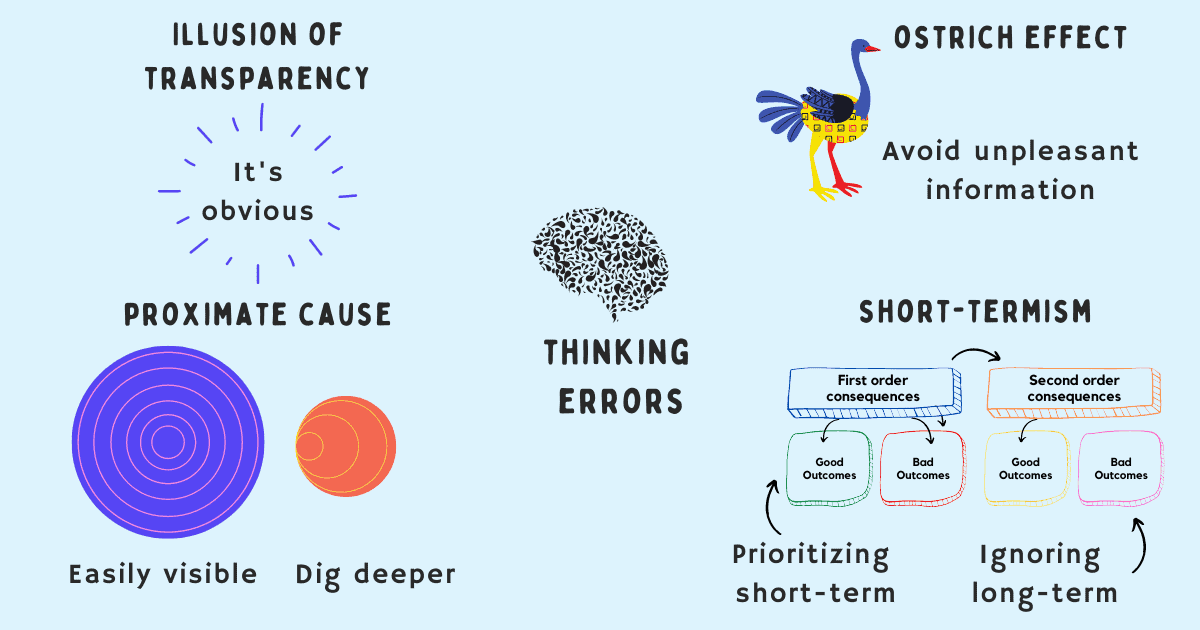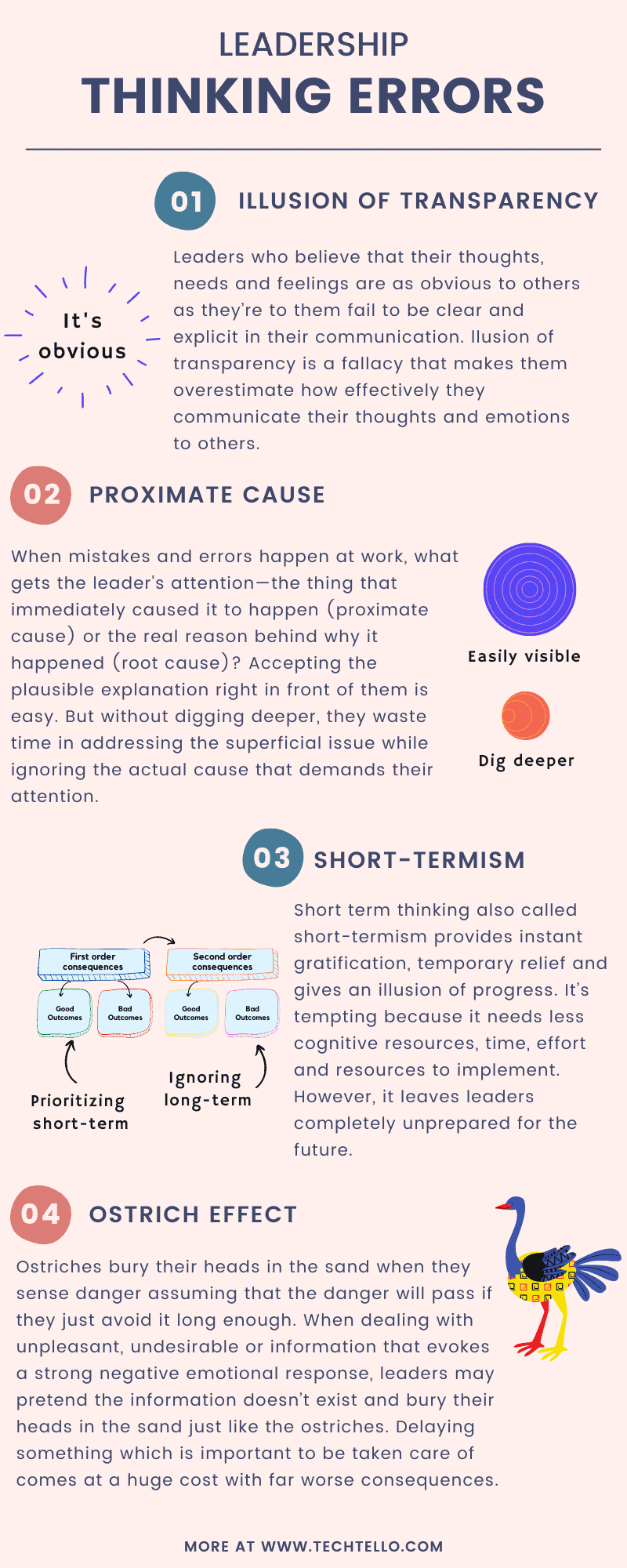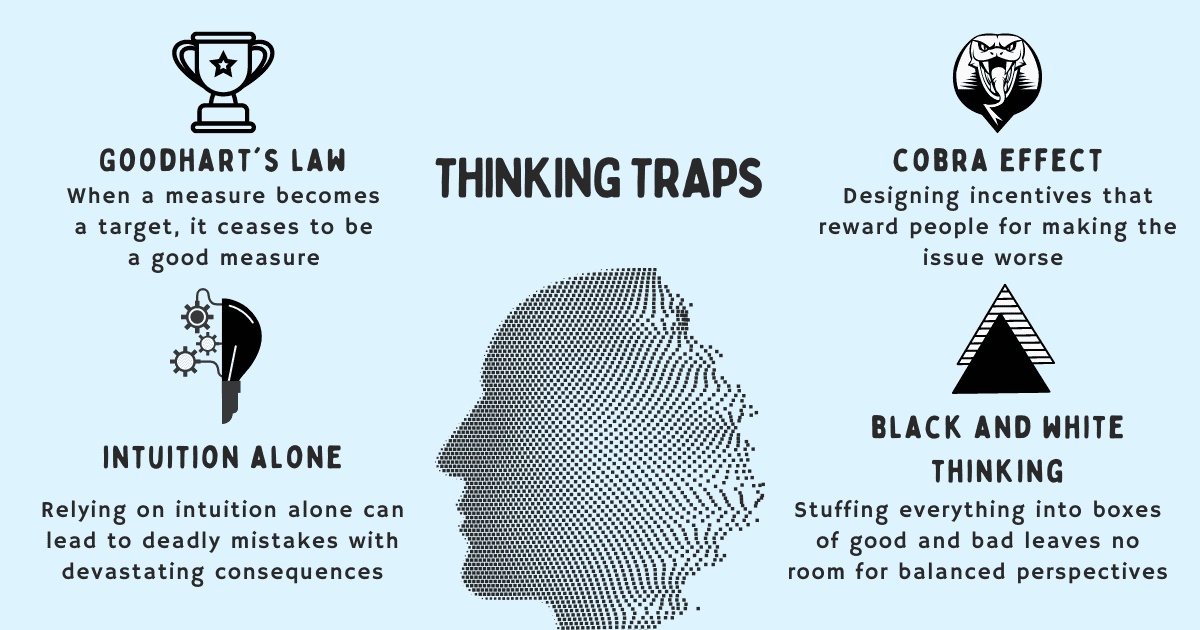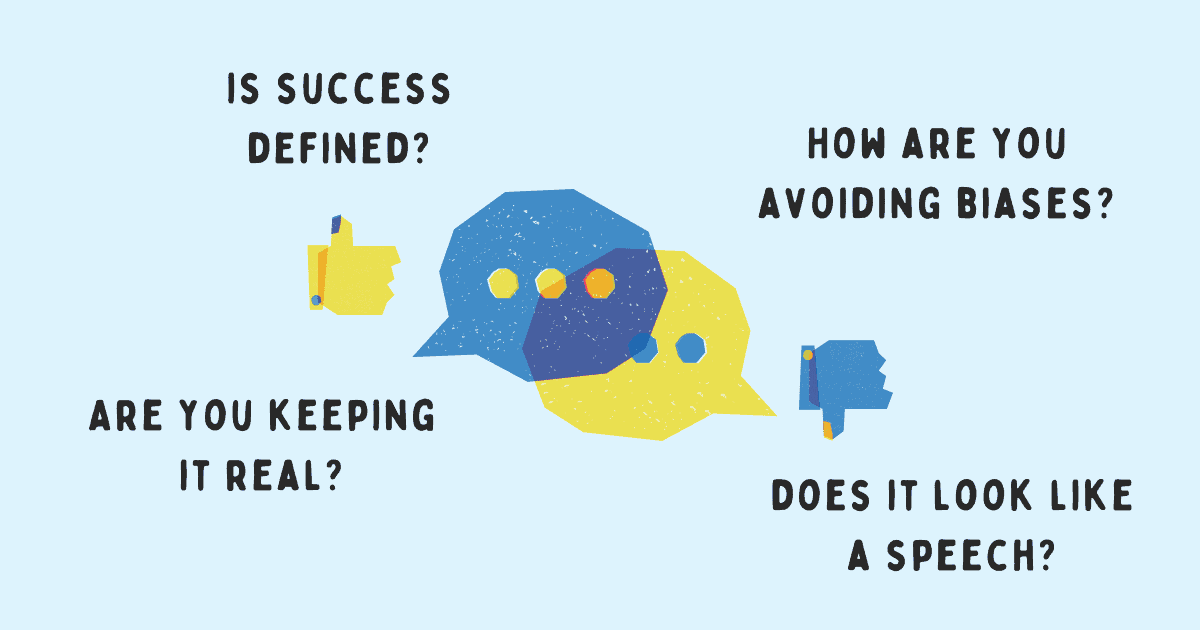These Thinking Errors are the Biggest Cause of Leadership Ineffectiveness

Leaders are ordinary human beings who make mistakes from time to time. While some mistakes are insignificant or have minor negative consequences, others might be potentially harmful and damaging to the organization and its people.
Most of these mistakes are unintentional—they stem from thinking errors, applying shortcuts and not using the right mental models. When leaders don’t pause and reflect, they make poor choices and terrible decisions which hurt the productivity of their people and performance of their entire organization.
Effective leaders aren’t perfect—they deal with the same limitations and biases of the mind as others. They too struggle with common thinking traps and occasional errors in judgment. However, instead of letting their mind lead the way, they pay attention to how they think, make decisions and what they can do to correct their mistakes.
Here are the 8 most important thinking traps that they watch out for and try to avoid:
- Illusion of transparency
- Proximate cause
- Short-termism
- Ostrich effect
- Goodhart’s law
- Cobra effect
- Black and white thinking
- Intuition alone
Let’s go in detail.
Illusion of transparency
Leaders who believe that their thoughts, needs and feelings are as obvious to others as they’re to them fail to be clear and explicit in their communication.
Illusion of transparency is a fallacy that makes them overestimate how effectively they communicate their thoughts and emotions to others.
We always know what we mean by our words, and so we expect others to know it too. Reading our own writing, the intended interpretation falls easily into place, guided by our knowledge of what we really meant. It’s hard to empathize with someone who must interpret blindly, guided only by the words. Be not too quick to blame those who misunderstand your perfectly clear sentences, spoken or written. Chances are, your words are more ambiguous than you think
— Eliezer Yudkowsky, Rationality
How to avoid illusion of transparency
To avoid the effect of illusion of transparency, remember:
- People can’t read your mind and predict what you need.
- People pay much less attention to you than you think.
- Others can’t correctly guess what you’re thinking or feeling.
- There’s a gap between how you experience something and how others view it.
- What’s obvious to you isn’t so obvious to others.
Explicit state what you want heard. Make sure others understand it the way you do, ask questions to validate your understanding, seek alignment and repeat what’s important often.
Example of illusion of transparency
John, VP of Engineering is tasked with a critical business milestone. When speaking to his team, he focuses on the specific outcomes they need to achieve without explicitly sharing why the project needs special attention or why he’s scared about not meeting the goals. He’s nervous about the project as it involves certain risks, but fails to say it out loud and discuss it with his team.
Illusion of transparency makes him assume others are thinking and feeling the same way he does only to be disappointed later when he discovers that his thoughts were evident to him, not so much to others.
Cognitive Distortions Bundle
Challenge and replace irrational thoughts with more realistic and adaptive thoughts.
Proximate cause
When mistakes and errors happen at work, what gets the leader’s attention—the thing that immediately caused it to happen (proximate cause) or the real reason behind why it happened (root cause)?
Accepting the plausible explanation right in front of them is easy. But without digging deeper, they waste time in addressing the superficial issue while ignoring the actual cause that demands their attention.
How to avoid proximate cause
Use the “five whys” technique to shift from proximate cause analysis to identifying the underlying root cause. Designed by Sakichi Toyoda, the technique was used within the Toyota Motor Corporation during the evolution of its manufacturing methodologies.
Ask why the mistake occurred and use the answer as the premise for the next question repeating this whole process five times to dig deeper into the actual cause of the issue. By repeating “why” five times, the nature of the problem and its solution becomes clear.
Example of proximate cause
Carol is heading new business initiatives. It’s two weeks beyond the promised deadline and Carol is impatiently waiting to hear good news. When she inquires about what’s causing the delay, she’s told “engineers are taking longer than expected.”
In this case, the proximate cause appears to be engineering delay, but that’s only part of the story. To identify the real root cause, let’s use the five whys technique:
- Q: “Why was the project delivered after the committed timeline?” A: Engineers took more time than expected.
- Q: “Why did the engineers need more time than expected?” A: They had to rework on a few requirements.
- Q: “Why was this rework required?” A: Product team changed requirements in between.
- Q: “Why did the product team change requirements?” A: Certain assumptions they made were no longer true.
- Q: “Why did they not validate these assumptions before starting the project ?” A: They assumed minimal effort in case the requirement changed later and failed to plan for it.
Short-termism
When leaders focus on short term outcomes, short term fixes and short term results, they fail to plan for the long term.
Short term thinking also called short-termism provides instant gratification, temporary relief and gives an illusion of progress. It’s tempting because it needs less cognitive resources, time, effort and resources to implement. However, it leaves leaders completely unprepared for the future. Optimizing for the present without considering what the future holds may actually turn out to be costly in the long run.
Failing to consider second- and third-order consequences is the cause of a lot of painfully bad decisions, and it is especially deadly when the first inferior option confirms your own biases. Never seize on the first available option, no matter how good it seems, before you’ve asked questions and explored
— Ray Dalio, Principles
How to avoid short-termism
Short-termism stems from the tendency to optimize short term pain at the cost of long term gain. A powerful mental model to avoid thinking this way is second order thinking. It unravels the implications of our decisions by thinking about its consequences in the future.
To develop second order thinking skills, follow these steps:
- Note down the first solution that comes to your mind with its immediate positives and negatives. This is your first order thinking.
- Then ask “What will be the future consequences of this decision” to evaluate the 2nd, 3rd level…nth level consequence. For each decision and level, write its corresponding positives and negatives.
- Ask questions, more and more questions to yourself to learn from those questions:
- What are my risks associated with this decision?
- How does my decision impact others?
- What do others think about my decision?
- Why do I think my decision is right?
- Can I apply Occam’s razor to seek simpler solutions?
- Choose the decision where second and third order consequences are positive even though first may not be positive (short term pain in favor of long term gain).
Recognize and apply feedback loops. It may not help with your current decision, but over time it will enable you to make better decisions.
Example of short-termism
Camilla is worried that her projects will be delayed if she’s unable to hire someone soon. She interviews Ron who appears to be a good fit for the current project. However, he lacks critical skills and experience to handle higher level responsibilities.
Instead of hiring someone by considering the future needs of the organization, she decides to get Ron onboard and address the problem later. Ron, who does well in the beginning, starts struggling as soon as the complexity of the work increases. Short-termism makes Camilla prioritize her short-term needs without thinking about the effects of her decision on the future.
Applying second order thinking in this case can help Camilla avoid this deadly mistake. By considering the future demands of the position, she can realize that it’s better to keep looking and find someone more suitable.
Ostrich effect
Ostriches bury their heads in the sand when they sense danger assuming that the danger will pass if they just avoid it long enough.
When dealing with unpleasant, undesirable or information that evokes a strong negative emotional response, leaders may pretend the information doesn’t exist and bury their heads in the sand just like the ostriches.
Delaying something which is important to be taken care of comes at a huge cost with far worse consequences—simple problems turn into a much more complicated situation when ignored long enough making it far worse and difficult to handle later.
How to avoid ostrich effect
To avoid reacting unfavorably to undesirable information:
- Take small steps. A small step that is hardly noticeable isn’t considered a threat by our brain.
- Ask powerful questions. Great questions have the power to unlock key pieces of information that can help you in making a better decision.
- Learn to embrace discomfort. See it as a sign that you’re stretching, expanding your skills and doing some worthwhile work.
- Remind yourself that delaying the problem won’t make it disappear, it will only make it worse.
Example of ostrich effect
Mendy is the Director of Product at a SaaS company. One of her high performers in the team isn’t behaving well recently. There are multiple complaints that he shouts and demeans others to get the job done. But instead of giving the feedback that this person needs, she keeps putting it off. The concern that he might leave the job if given such feedback makes Mendy avoid the conversation altogether.
Just like the ostrich, she hopes the problem will disappear if she just avoids it long enough. However, leaving the conflict unresolved and not setting behavioral expectations with the person only makes the situation worse. Multiple team members decide to quit as they refuse to put up with the toxic work environment.
In life and business, the person with the fewest blind spots wins. Removing blind spots means we see, interact with, and move closer to understanding reality. We think better. And thinking better is about finding simple processes that help us work through problems from multiple dimensions and perspectives, allowing us to better choose solutions that fit what matters to us. The skill for finding the right solutions for the right problems is one form of wisdom
— Shane Parrish, The Great Mental Models
In this article, I have covered the first 4 thinking errors. Next article will cover the remaining 4.
Summary
- Thinking errors are a common part of being human. However, as a leader some mistakes can be damaging to the organization and its people.
- Effective leaders pay conscious attention to how they think and make decisions. They watch out for the thinking traps that can lead to errors in judgment.
- Illusion of transparency can prevent them from effectively communicating by assuming that their thoughts and feelings are as obvious to others as they’re to them.
- When errors happen at work, mistaking proximate cause for the root cause prevents leaders from digging deeper and uncovering the real reason.
- Short-termism leads to short-term thinking which makes leaders optimize short-term without planning for the long-term. It’s costly and leaves them unprepared to handle future demands and its needs.
- When leaders behave like ostriches and bury their heads in the sand to avoid dealing with unpleasant information, it makes the problem worse, not disappear.






























